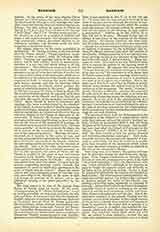

Marriage, MYSTICAL.—In the Old and the New Testament, the love of God for man, and, in particular His relations with His chosen people (whether of the Synagogue or of the Church), are frequently typified under the form of the relations between bridegroom and bride. In like manner, Christian virginity has been considered from the earliest centuries as a special offering made by the soul to its spouse, Christ. Nothing else seems to have been meant in speaking of the mystical nuptials of St. Agnes and of St. Catherine of Alexandria. These primitive notions were afterwards developed more completely, and the phrase mystical marriage has been taken in two different senses, the one wide and the other more restricted.
(I) In many of the lives of the saints, the wide sense is intended. Here the mystical marriage consists in a vision in which Christ tells a soul that He takes it for His bride, presenting it with the customary ring, and the apparition is accompanied by a ceremony; the Blessed Virgin, saints, and angels are present. This festivity is but the accompaniment and symbol of a purely spiritual grace; hagiographers do not make clear what this grace is, but it may at least be said that the soul receives a sudden augmentation of charity and of familiarity with God, and that He will thereafter take more special care of it. All this, indeed, is involved in the notion of marriage. Moreover, as a wife should share in the life of her husband, and as Christ suffered for the redemption of mankind, the mystical spouse enters into a more intimate participation in His sufferings. Accordingly, in three cases out of every four, the mystical marriage has been granted to stigmatics. It has been estimated by Dr. Imbert that, from the earliest times to the present, history has recorded seventy-seven mystical marriages; they are mentioned in connection with female saints, beatae, and venerabiles—e.g. Blessed Angela of Foligno, St. Catherine of Siena, St. Colette, St. Teresa, St. Catherine of Ricci, Venerable Marina d’Escobar, St. Mary Magdalen de’ Pazzi, St. Veronica Giuliani, Venerable Maria de Agreda. Religious art has exercised its resources upon mystical marriage, considered as a festive celebration. That of St. Catherine of Alexandria is the subject of Memling’s masterpiece (in the Hospital St. Jean, Bruges), as also of paintings by Jordaens (Madrid), Correggio (Naples and the Louvre), and others. Fra Bartolommeo has done as much for St. Catherine of Siena.
(2) In a more restricted sense, the term mystical marriage is employed by St. Teresa and St. John of the Cross to designate that mystical union with God which is the most exalted condition attainable by the soul in this life. It is also called a “transforming union”, “consummate union”, and “deification”. St. Teresa likewise calls it” the seventh resting-place” of the “interior castle”; she speaks of it only in that last treatise which she composed five years before her death, when she had been but recently raised to this degree. This state comprises three elements: (a) The first is an almost continual sense of the presence of God, even in the midst of external occupations. This favor does not of itself produce an alienation of the senses; ecstasies are more rare. Nor does this permanent sense of God‘s presence suffice to constitute the spiritual marriage, but is only a state somewhat near to it. (b) The second element is a transformation of the higher faculties in respect to their mode of operation: hence the name “transforming union”; it is the essential note of the state. The soul is conscious that in its supernatural acts of intellect and of will, it participates in the Divine life and the analogous acts in God. To understand what is meant by this, it must be remembered that in heaven we are not only to enjoy the vision of God, but to feel our participation in His nature. Mystical writers have sometimes exaggerated in describing this grace; it has been said that we think by the eternal thought of God, love by His infinite love, and will by His will. Thus, they appear to confound the two natures, the Divine and the human. They are describing what they believe they feel; like the astronomers, they speak the language of appearances, which we find easier to understand. Here, as in human marriage, there is a fusion of two lives. (c) The third element consists in an habitual intellectual vision of the Blessed Trinity or of some Divine attribute. This grace is sometimes accorded before the transforming union. Certain authors appear to hold that in the transforming union there is produced a union with the Divine Word more special than that with the other two Divine Persons; but there is no proof that this is so in all cases. St. Teresa gives the name of “spiritual betrothal” to passing foretastes of the transforming union, such as occur in raptures.
AUG. POULAIN

